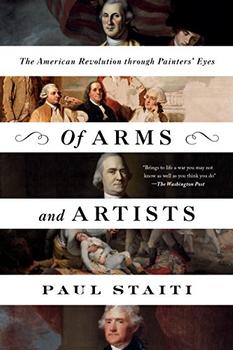Summary | Excerpt | Reviews | Beyond the Book | Readalikes | Genres & Themes | Author Bio

Critics' Opinion:
Readers' Opinion:
First Published:
Oct 2016, 400 pages
Paperback:
Sep 2017, 400 pages
 Book Reviewed by:
Book Reviewed by:
Emily-Jane Hills Orford
Buy This Book
The slashing of Washington's portrait tells us that works of art carried extra weight in a time of revolution, and that they could be vivid enough to provoke disfigurement or destruction. If the work of art was an official portrait, such as Peale's Washington, it was doubly vulnerable to attack. And if the artist himself was perceived to be a political ally of the person in the portrait, as Peale was, it was triply vulnerable. That ancient logic had been repeated countless times over the centuries: If you can't kill the person, you can at least mutilate his image and send a strong message to him and his supporters. A symbolic death even had some advantages over the real thing in that it was possible not only to destroy Washington's image, but also to insult the values present in that image: respectability, pride, success, smugness, and anything else that Loyalist Philadelphians saw in it. Loyalists could not do anything to reverse the British defeat at Princeton in 1777, or to fend off the doomed British campaign at Yorktown, but they could at least erase the satisfied look on Washington's face and turn a handsome picture into something repulsive.
The slashing episode in Philadelphia was just one instance in which the defacement or destruction of a portrait underscored the special significance that artworks possessed during the Revolution. Loyalists attacked Patriot images and Patriots attacked monarchical images. During the British military occupation of colonial Boston in 1769, the leading painter in the city, John Singleton Copley, was hired to paint a portrait of the despised British colonial governor of Massachusetts, Francis Bernard. After it was installed in Harvard Hall in Cambridge, radical activists broke in and cut the heart area out of the seemingly banal portrait. A rattled Copley was called in to repair the damage, prompting one Boston newspaper to comment that "our American limner, Mr. Copley, by the surprising art of his pencil has actually restored as good a heart as had been taken from it." The commentator sarcastically added, "upon a near and accurate inspection, it will be found to be no other than a false one." Not even the great Copley, the best artist in America, could fix the heartless Governor Bernard.
In 1770, the British erected a giant equestrian statue of King George III on Bowling Green in New York City, accompanied by toasts, military music, and artillery fire. Covered in shiny gold leaf and surrounded by an iron fence, it was the public assertion of British authority in the city. Six years later, in the summer of 1776, as the British were poised to take the city with an overwhelming force of 32,000 men, Washington gathered his deflated Continentals into defensive positions in lower Manhattan. Though defeat was imminent, on July 9 their spirits lifted when John Hancock sent Washington a copy of the new Declaration of Independence and asked that he inform his men of it.
After dinner that evening, Washington ordered it read aloud on the Commons, on Broadway near present-day City Hall. In unison, the troops shouted "three Huzzas," then raced down to Bowling Green, tore down the statue of the King, dismembered it, and dragged it through the streets of New York before it was recycled into musket balls that were used against the British army.7 In the logic of the Revolution, the best way for American troops to diminish the King's living power was to destroy his monument and then weaponize the metal for use against him. Works of art were thus capable of arousing potent emotions in times of intense political change, when all the sentiments active in civic disputes and battlefield contests also crystalized around and adhered to paintings and sculptures.
* * *
The five great American artists of the late eighteenth century— Peale, Copley, Benjamin West, John Trumbull, and Gilbert Stuart—had started their careers as British subjects, loyal to the Crown. But the Revolution begged them to examine whether they intended to carry forward their inherited status or become contributing citizens in the new republic. As in no previous generation, they lived through a time of breathtaking historical change that deserved and demanded to be painted for the people of their time, and for posterity. They recognized the gravity of the moment and had their futures unavoidably transformed by the great events of the era: independence, warfare, diplomatic triumph, near collapse, sovereignty, the Constitution, and the rise of the presidency and the federal government. In such a charged environment, their experiences were compelling and captivating at the best of times, confusing and frightening at the worst, and like everyone else they had to confront the inherent incomprehensibility of the events swirling around them. They attempted to make sense of it all by turning to brushes and canvases. Works of art became their means of narrating the Revolution to themselves and to citizens of the new republic.
Excerpted from Of Arms and Artists by Paul Staiti. Copyright © 2016 by Paul Staiti. Excerpted by permission of Bloomsbury USA. All rights reserved. No part of this excerpt may be reproduced or reprinted without permission in writing from the publisher.





The Funeral Cryer by Wenyan Lu
Debut novelist Wenyan Lu brings us this witty yet profound story about one woman's midlife reawakening in contemporary rural China.
Your guide toexceptional books
BookBrowse seeks out and recommends the best in contemporary fiction and nonfiction—books that not only engage and entertain but also deepen our understanding of ourselves and the world around us.